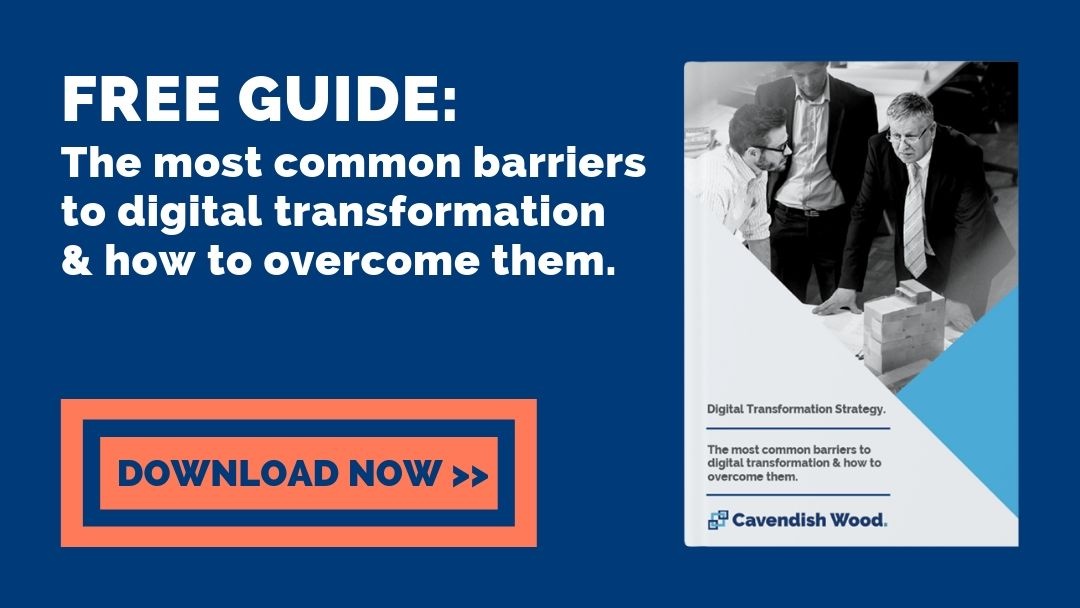
I recently re-read the Altimeter report on the state of digital transformation for 2019. Now, in the context of the Covid-19 recession, the section around key challenges resonated. This article looks at the three key challenges faced by executives covered by the report, their underlying causes and how to mitigate them.
The report states that the top 3 challenges, currently facing executives are:
- “The top challenge reported by executives is the lack of data or ROI to justify the value of digital transformation (29%). The percentage of executives that cited this as their top challenge went up 159% from last year.”
- “At 28%, the second top challenge cited is budget and the perception of digital transformation as a cost centre, not as an investment in performance and growth.”
- “The third most difficult challenge experienced by companies we surveyed was resistance to change and human dynamics like workplace politics, egos, sabotage and fear (26%), rising from sixth place in 2017.”
These issues signal that all is not necessarily well in the land of transformation.
Digital Transformation is the most important investment of a generation, and when executives are unable to justify spend because of a lack of visible ROI data, forecasts or benefits realisation, this largely stems from the same underlying problems. These problems are common across every sector and are difficult to solve, but with the right strategy and governance frameworks in place, it is more than possible to break through and get some necessary and significant digital change happening.
If the executive team or stakeholders are experiencing a lack of ROI data this quite rightly stops transformation in its tracks. Funnelling money into a perceived black hole for no tangible benefit isn’t high on the priority lists of many boards. This situation is a clear indication of several things, which I’ll explore with you next.
Shared vision for transformation.
Firstly, it’s likely that there is no enterprise-wide shared vision for transformation. A shared vision for transformation is critical to ensure that all digital initiatives contribute and further the objectives of the vision. This might include five or six high-level objectives or transformation goals, a summary of where you are today and where you need to get to. The “where” is driven by analysis of internal and external gaps that need to be mitigated. The gaps I’m referring to are between what your customers expect, and what you actually deliver as well as the gaps between your hierarchies and business silos.

The shared vision should also include the pathways or outcomes required to deliver the vision. It is also a living construct. It needs to change to remain in line with external digital change. This in itself is a completely new way of thinking and can be difficult to achieve for companies who are low down on the digital maturity curve. Coupled with this strategy, there must be a leadership group responsible for both starting, driving and maintaining the digital programmes and initiatives across the company. This cannot be IT. Ideally, the steering group should be led by the CEO, from the top down, across the entire organisation.
This is especially important in digital transformation programmes because of the cross-functional nature of the work being undertaken. You need a motivated and digitally aware leadership group to remove barriers and free up staff from business as usual activities, especially in the early stages of transformation.
Transformation must be business-led.
Secondly, in the organisations that have these issues, digital transformation is very often technology-led. It’s more than likely it’s an IT responsibility and is simply the delivery of technology. This could include undertaking things like moving to Microsoft 365 and upgrading landlines with Skype for Business. There isn’t any inherent value in doing this, it’s expensive, often a major programme and almost always underwhelming for business users. It’s just email, it looks the same, it will almost certainly be used the same, and the status quo is preserved. It’s no surprise that the board see this as a cost centre and not an investment. This is technology transformation, not digital transformation.

What is even worse, is the upgrade or replacement of systems which are pushed to the business with little or no cross-functional collaboration. They don’t solve any issues or enable digital transformation. People simply carry on doing whatever they have been doing for the last decade, but with a new system they probably didn’t even want, and certainly don’t like.
Lack of business engagement.
The third underlying cause is a lack of business engagement. Digital transformation is a business-led activity, and shouldn’t be led by technology or IT.
The whole point of transformation is to deliver the digital services and value that your customers expect, and to utilise digital technology and new ways of working to create efficiencies, savings and new revenue streams. Only the people at the coal face who deliver the services, use the systems, engage with the customers and experience the issues can lead the transformation. This is because they are the ones that will see the opportunities.

There is no possible way that IT can know where the opportunities for improvement, new products and savings are. Engaging the business, identifying the projects that have value, ensuring the initiatives underpin the vision and then deploying empowered, cross-functional teams to deliver them is the only way to achieve meaningful transformation.
Lacking the innovation mindset.
For a company to even survive, let alone thrive in the digital age, it must embrace and encourage new ways of working, create a culture of innovation, and put the customer at the heart of everything it does.
Ultimately, in the new digital age of business, the traditional siloed, inward-looking technology change is simply not enough. There must be innovation, collaboration and empowerment at every level to deliver value for the customer.
This is one of the most common reasons that companies fall behind the digital curve. The kind of mindset needed for transformation is one that embraces change, rewards innovation, takes risks, learns quickly from mistakes and is highly collaborative. Without this mindset, transformation isn’t focussed on the right outcomes and opportunities, and therefore doesn’t create the value that executives need. This is because they simply don’t see innovation (especially technical innovation) as their responsibility. They’re not accountable in the right way. Most have accountability that has nothing to do with the company’s purpose or mission.
Poor accountability also removes any sense of urgency or time-based pressure. This is especially prevalent in Public Sector organisations that have a captive market. This, in turn, is exacerbated by inwardly focused management that create their own methods of performance management that do not contribute towards the company’s mission.
Support functions such as IT and HR need to be just as accountable for the productivity they enable. There is no part of any organisation that shouldn’t have accountability that underpins the mission statement of the company.
The solution.
The solution to all of the above issues and therefore the key issues from the report, can be achieved through a variety of methods and ways of working, which underpin a sustainable culture of digital delivery.
The critical component, however, is the introduction of a governance framework and toolset which facilitates business engagement, and therefore induces culture change and instils the innovation mindset across the enterprise.

This framework must be rolled out to the entire organisation with an adoption mandate from the CEO. It must be capable of both capturing and forecasting the benefits of all digital initiatives and delivering real-time reporting to stakeholders and executives around ongoing and proposed initiatives.
This flushes out the transformation opportunities currently hidden in the business, empowers users across the organisation and makes them accountable for the transformation of their business areas. Engaging them to lead their own transformation means that they immediately see the benefit. Creating accountability for this also reinforces and sustains the new mindset. Remember this isn't a one time piece of change. You are transforming your business to work in new ways for good.
Once in place, both key challenges cited in the report in the first paragraph of this article should, to a large extent be mitigated.
Executives have a real-time view of every digital initiative and the forecasted service or financial benefits. The adoption of the framework ensures that it’s the business leading the transformation, and not simply having technology pushed to them from IT.
Of course, this must be preceded by the creation of the shared vision for transformation, the steering group and by the CEO having the appetite to transform his/her organisation. Without these three components, its highly likely that transformation as an enterprise journey will never really commence. There are likely to be pockets of innovation within an organisation, but unless these areas can show their results and influence the people at the top, it’s largely impossible to transform.



